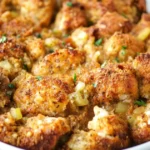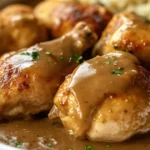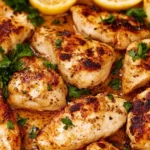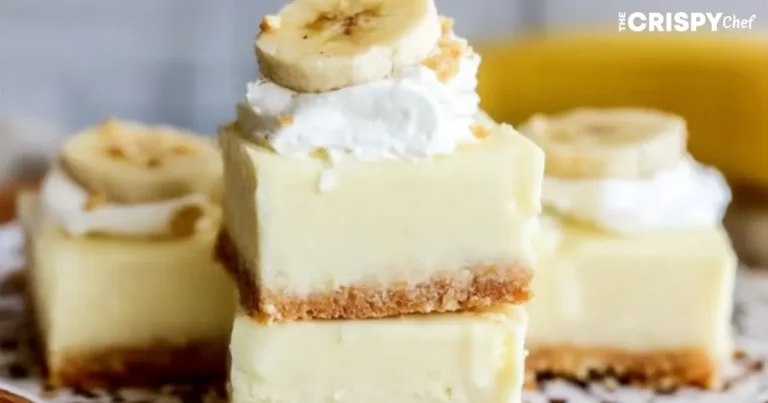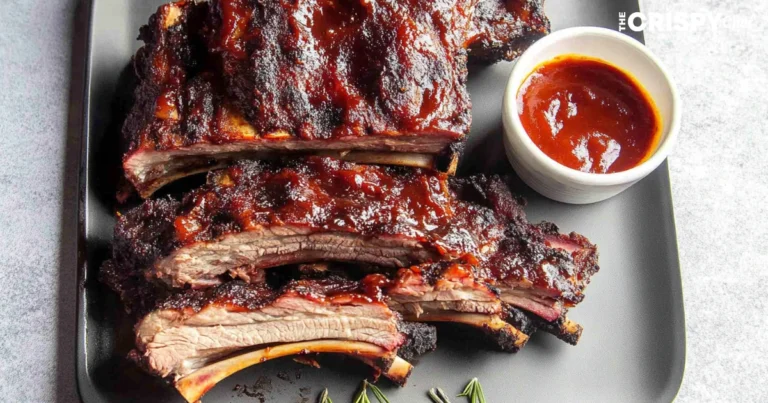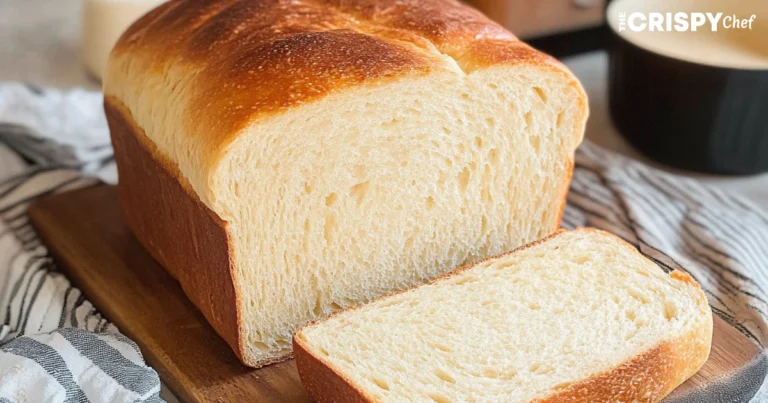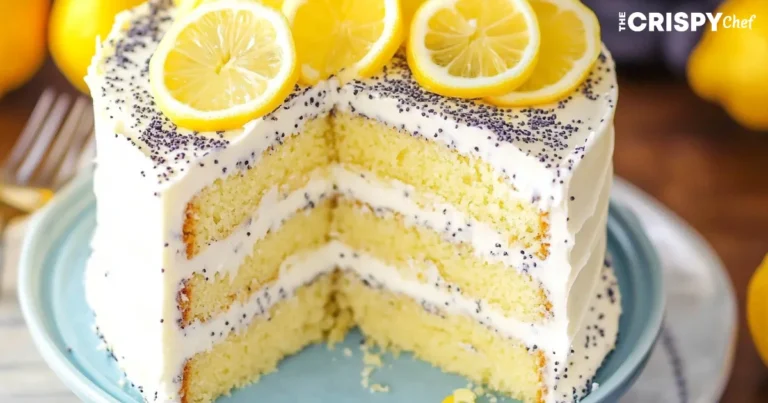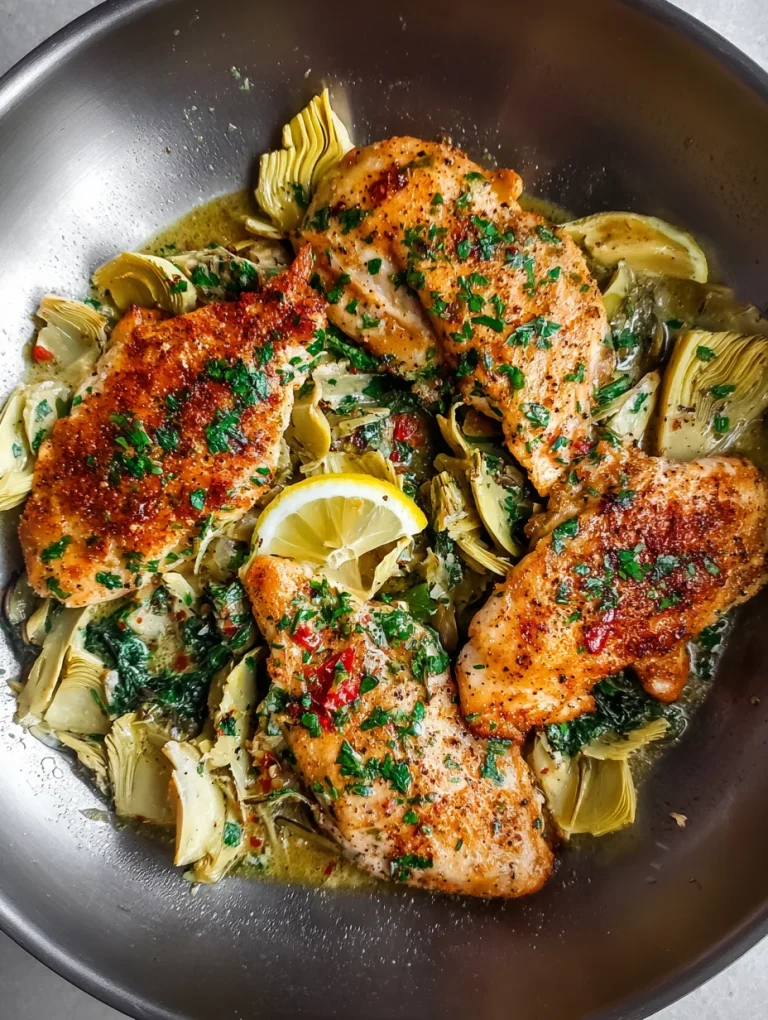Take your dinner game up a notch with this amazing cast iron skillet Cornish hen recipe. It’s a fancy way to cook these smaller, tender birds. The recipe uses both searing and roasting to get a crispy outside and a juicy inside.
Cornish hens, which weigh 1-2 pounds, are a tasty choice instead of regular chicken. They’re great for special meals or cozy dinners with friends.
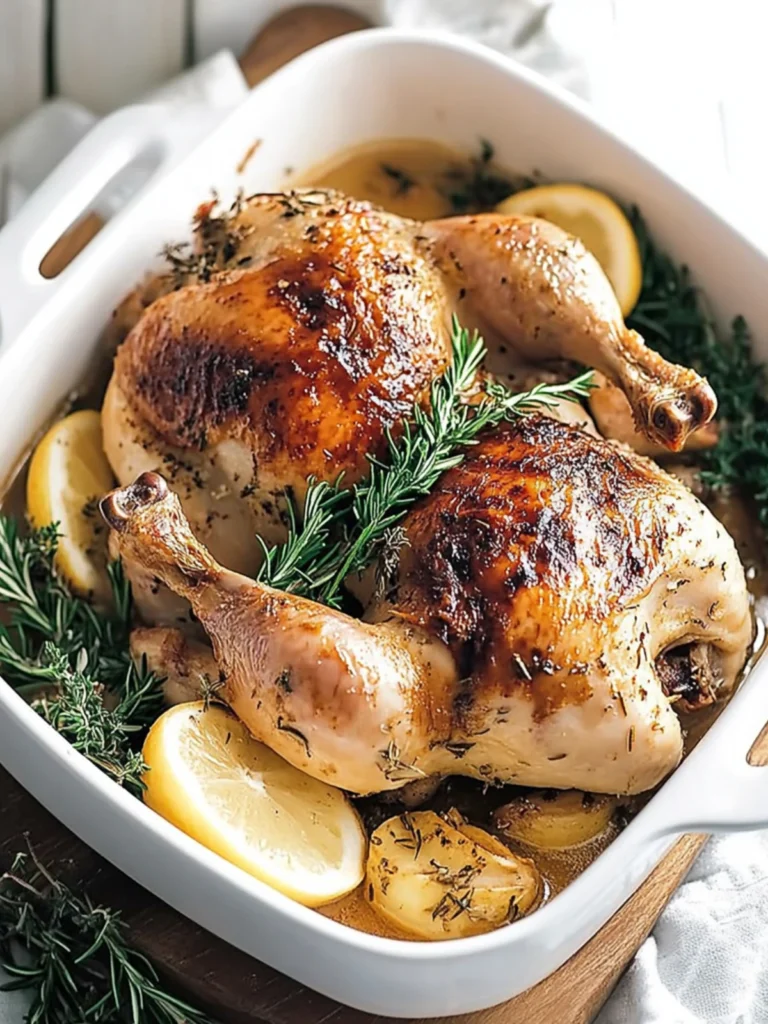
Key Takeaways
- Cornish hens are a smaller, more tender alternative to regular chicken
- This recipe utilizes a cast iron skillet for optimal searing and browning
- The cooking method combines searing and roasting for a crispy, juicy result
- Cornish hens are an excellent choice for special dinners or intimate meals
- The recipe is designed to serve one hen per person
Understanding Cornish Game Hens: A Culinary Introduction
Cornish game hens, also known as Cornish hens, are a special type of poultry. They are small, weighing 1 to 2 pounds. Their tender texture and subtle flavor make them stand out from bigger chickens.
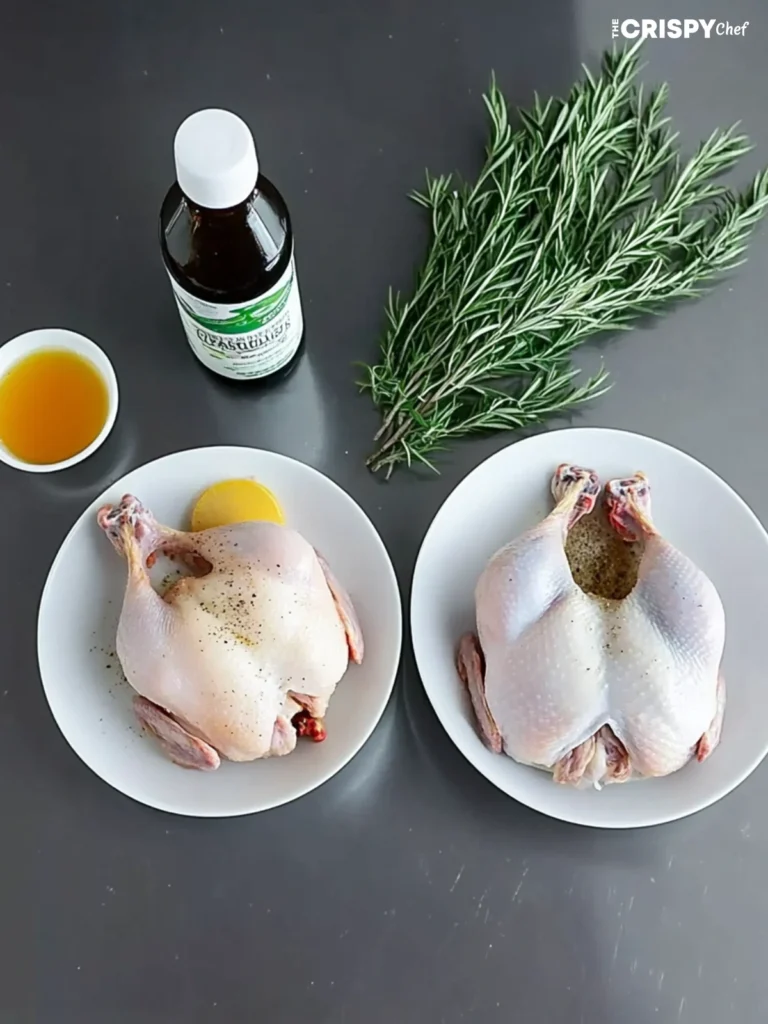
What Makes Cornish Hens Special
Cornish hens are young chickens, picked when they’re under 5 weeks old. This early picking makes their meat tender and mild. They soak up flavors well, making them fun to cook with.
Size and Flavor Profile
Cornish hens are perfect for serving one person. They cook fast, which is great for quick meals or special events. Their flavor is delicate and sweet, with a juicy texture.
Benefits of Cooking Cornish Hens
- Portion control: The single-serving size of Cornish hens makes them a great option for individual meals or when entertaining, as each guest can enjoy their own bird.
- Quicker cooking times: Cornish hens require less time in the oven or on the stovetop, making them a convenient and time-saving choice for busy cooks.
- Elegant presentation: Serving Cornish hens whole on the plate adds a touch of sophistication and visual appeal to any meal.
- Flavor absorption: Cornish hens readily absorb the flavors of marinades, seasonings, and cooking techniques, allowing for a wide range of culinary experimentation.
Exploring cornish game hens can introduce you to a new world of tasty and beautiful poultry dishes. Discover the unique traits of these small birds and explore endless poultry cooking options.
Essential Ingredients and Equipment for Perfect Results
Making a delicious Cornish-hen dish begins with top-notch ingredients and the right tools. You’ll need tender Cornish hens, aromatic spices, and herbs. These all add to the dish’s flavor. Also, using a cast iron skillet or grill pan is key for a great sear and texture.
First, you’ll need Cornish hens, which are small chickens weighing 1 to 2 pounds. They are slaughtered at a young age. For a meal, serve one hen per person or three for four people.
You’ll also need garlic, paprika, allspice, thyme, black pepper, nutmeg, olive oil, salt, lemon or lime juice, celery, onion, and chicken broth. These ingredients will help make marinades, rubs, and pan sauces. They add amazing flavor to your Cornish hens.
For cooking, a cast iron skillet or grill pan is crucial for a perfect sear. A food processor is handy for making marinades and herb mixtures. And, a roasting pan is needed for baking.
By choosing fresh, quality ingredients and using the right tools, you’ll make a Cornish hen dish that will wow everyone. Let’s look at the important steps for achieving perfect results.
Preparing Your Cornish Hens for Cooking
Getting your Cornish hens ready is key to a delicious meal. First, thaw them in the fridge overnight if they’re frozen. Then, dry them well with paper towels to help the skin get crispy.
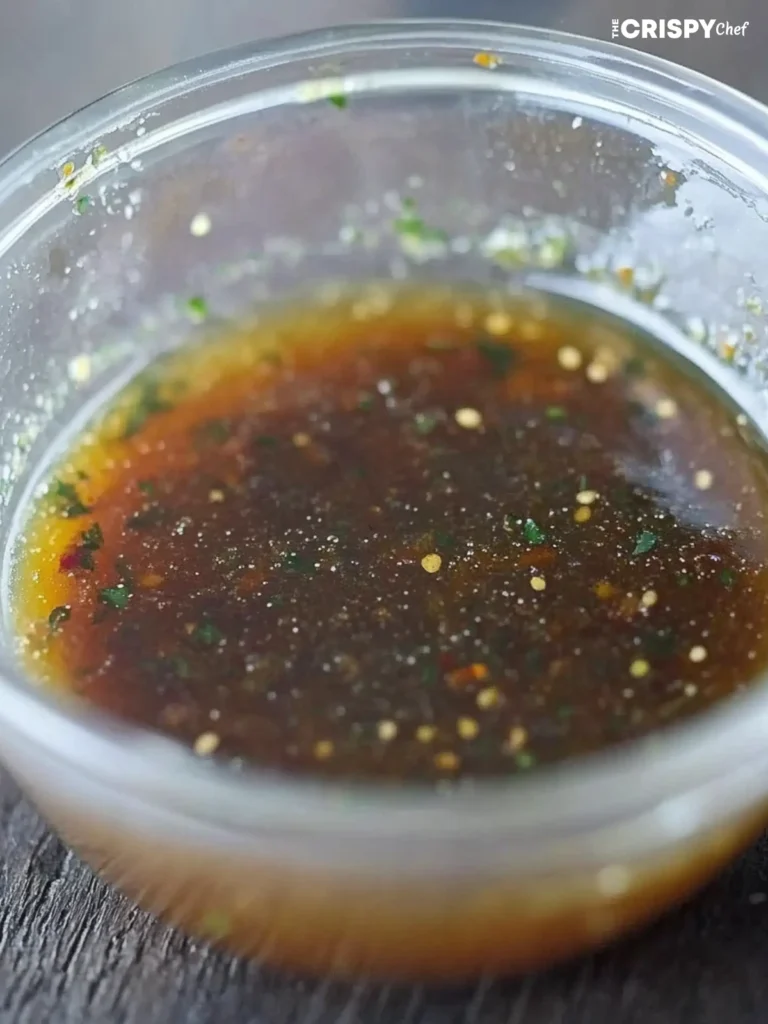
Thawing and Patting Dry
Thawing the hens in the fridge overnight is the safest method. It keeps the meat quality and texture good. After thawing, dry the hens with paper towels to make the skin crispy.
Seasoning Techniques
Seasoning is crucial for great flavor in your Cornish hens. Rub a spice blend under the skin, making sure it reaches the meat. Coat the hens well inside and out. Use garlic, paprika, thyme, allspice, and black pepper for flavor.
Stuffing Options
- Stuff each hen with lemon wedges, garlic, and herbs like rosemary or thyme for extra flavor.
- Onion, celery, and carrots make a tasty stuffing that adds flavor to the meat.
- Or, skip stuffing and place butter or bacon under the skin for a rich taste.
With the hens thawed, dried, and seasoned, you’re ready for the next steps. Proper preparation is essential for a fantastic Cornish-hen dish.
The Perfect Marinade for Flavorful Cornish Hens
Start by making a great marinade to boost your Cornish hens’ flavor. Mix aromatic spices, herbs, and citrus to create a cornish-hen marinade. This marinade adds flavor enhancement and tenderizes the poultry marinade recipe, making the meat juicy and delicious.
To make the marinade, mix garlic, paprika, allspice, thyme, black pepper, nutmeg, olive oil, salt, and citrus juice in a food processor. Blend until smooth. Coat the Cornish hens with this marinade, covering skin and meat. Let them marinate for at least an hour, or better yet, overnight in the fridge.
| Ingredient | Quantity |
|---|---|
| Garlic | 3 cloves, minced |
| Paprika | 1 teaspoon |
| Allspice | 1/2 teaspoon |
| Thyme | 1 tablespoon, freshly chopped |
| Black Pepper | 1/2 teaspoon |
| Nutmeg | 1/4 teaspoon |
| Olive Oil | 2 tablespoons |
| Salt | 1 teaspoon |
| Citrus Juice | 2 tablespoons, lemon or orange |
Marinating the Cornish hens in this flavorful mix will bring out amazing aromas and tastes. You’ll enjoy a juicy, tender, and flavor-enhanced meal from your cornish-hen marinade efforts.
Cornish Hen Recipe Seared Cast Iron Skillet
Discover the secret to perfectly seared Cornish-hens with this easy cast iron skillet method. High heat creates a golden-brown crust and keeps the juices in for a delicious taste.
Searing Process
Start by heating your cast iron skillet over medium-high. When it’s hot, put your seasoned Cornish-hens skin-side down. Don’t move them for 2-3 minutes to get a crispy, caramelized skin.
Temperature Control
Keeping the heat steady is key for searing. Watch the temperature and adjust it to avoid burning. Aim for a consistent high heat to brown the hens evenly without overcooking the inside.
Timing Guidelines
- Sear the Cornish-hens for 2-3 minutes per side, or until the skin is golden brown.
- Then, put the skillet in a preheated 425°F oven.
- Roast the hens for 45 minutes to 1 hour, depending on size, until they reach 165°F inside.
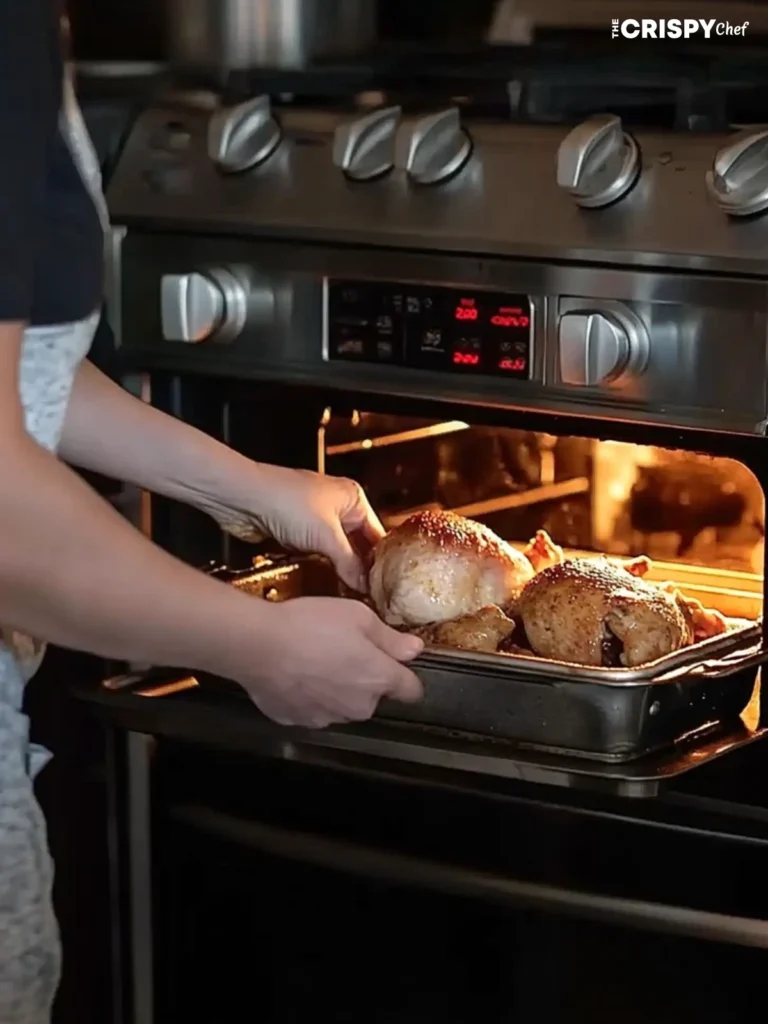
By following these steps, you’ll get Cornish hens with a crispy crust and juicy inside. They’re cooked to perfection in your cast iron skillet.
“The secret to succulent Cornish-hens is all in the sear. Mastering the cast iron skillet technique is the key to unlocking their full flavor potential.”
Roasting Techniques and Temperature Guidelines
Roasting Cornish hens to perfection needs careful attention to temperature and cooking times. First, sear the hens in a cast iron skillet. Then, move them to the oven for the final cooking stage.
Preheat your oven to 425°F. Place the seared Cornish-hens in the oven and roast for about 25 minutes. This high temperature ensures a crispy, golden-brown skin.
After 25 minutes, lower the oven temperature to 350°F. Roast the hens for another 20-25 minutes. Baste them every 15 minutes with pan juices or chicken broth to keep them moist and flavorful.
Check the internal temperature of the Cornish-hens with a meat thermometer. The thickest part of the thigh should reach 165°F. Once it does, remove the hens from the oven and let them rest for 10-15 minutes before serving.
Resting the Cornish hens allows the juices to spread evenly. This makes the meat juicy and tender. With these precise roasting techniques and temperature guidelines, you can make restaurant-quality Cornish hens at home.
| Oven Temperature | Roasting Time | Internal Temperature |
|---|---|---|
| 425°F | 25 minutes | N/A |
| 350°F | 20-25 minutes | 165°F |
The secret to perfectly roasted Cornish-hens is the right oven temperature and cooking times. Also, use a meat thermometer to ensure they are cooked through. Follow these tips for juicy, flavorful Cornish-hens every time.
Creating Complementary Pan Sauces
Elevate your Cornish-hen dish with a tasty pan sauce. Use the flavorful drippings from the roasted birds. This sauce will perfectly match the juicy, tender meat of your Cornish-hens.
Classic Pan Sauce Recipe
After removing the roasted Cornish-hens, deglaze the skillet with white wine or chicken broth. Scrape up browned bits stuck to the bottom. These bits add incredible depth of flavor to the sauce.
Toss in fresh herbs like rosemary or thyme. Let the mixture simmer until it’s reduced by half. Finish with cold butter, stirring until it melts and emulsifies. This creates a rich, velvety texture.
Flavor Enhancement Tips
For a more flavorful pan sauce, add extra ingredients. Minced shallots or garlic add a savory base. A splash of cream or Dijon mustard adds a creamy, tangy element.
Experiment with different herbs, spices, and acidic ingredients. Find the perfect flavor that complements your Cornish-hen dish.
Strain the pan sauce through a fine-mesh sieve before serving. This ensures a silky smooth texture. Drizzle the vibrant, flavorful sauce over your perfectly cooked Cornish-hens. Enjoy the symphony of flavors in every bite.
Side Dish Pairings and Serving Suggestions
Pairing Cornish-hens with side dishes is a fun task. Roasted veggies like carrots, potatoes, and Brussels sprouts are great. They add color, texture, and flavors to your meal. A flavorful rice or quinoa pilaf is also a good choice, especially for a heartier meal.
A fresh mixed green salad is perfect for a lighter side. You can also try creamy mashed potatoes, tangy cranberry sauce, or tender steamed asparagus. The goal is to make a balanced and appealing plate that highlights the juicy Cornish-hens.
For an elegant touch, serve each Cornish-hen whole on individual plates. This adds sophistication and lets guests see the full dish. Or, carve the hens before serving for easier enjoyment.
| Side Dish | Serving Suggestion |
|---|---|
| Roasted Vegetables (Carrots, Potatoes, Brussels Sprouts) | Serve alongside the Cornish hens for a hearty, balanced meal. |
| Rice or Quinoa Pilaf | A flavorful grain-based side that complements the Cornish hens perfectly. |
| Mixed Green Salad | A refreshing and light accompaniment to the Cornish hens. |
| Mashed Potatoes | A classic pairing that adds creaminess and richness to the meal. |
| Cranberry Sauce | A tangy and sweet complement to the savory Cornish hens. |
| Steamed Asparagus | A simple, elegant side that allows the Cornish hens to shine. |
Choosing the right side dishes can make your cornish-hen meal a hit. It will impress your guests and highlight the deliciousness of the poultry.
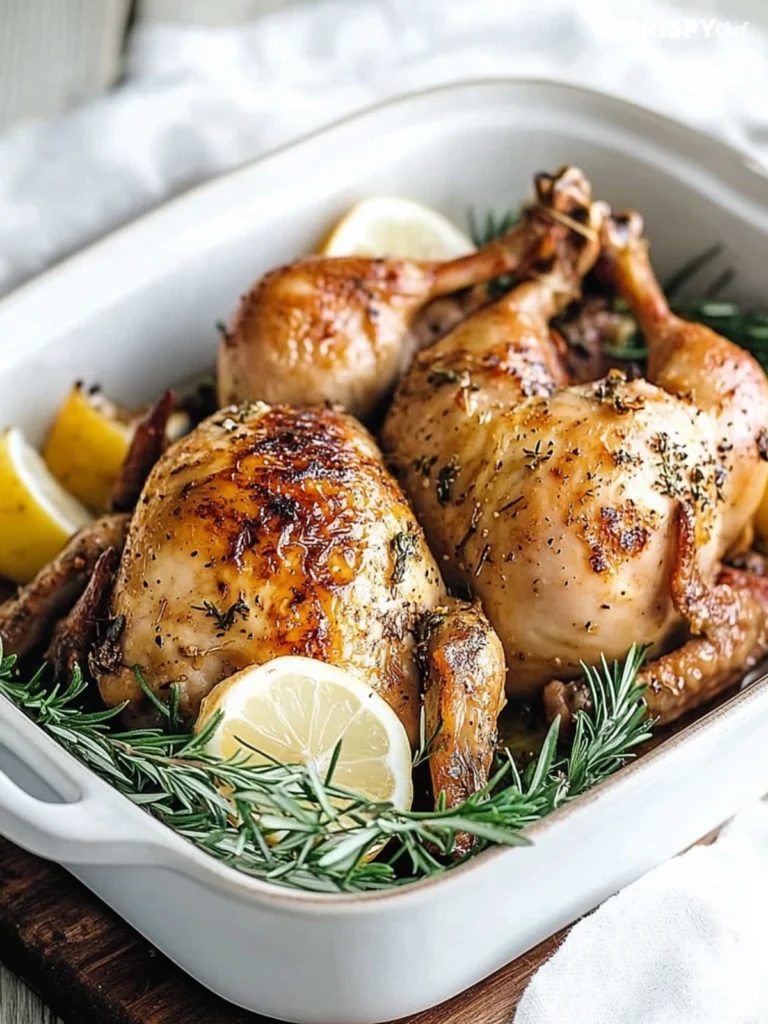
Storage and Leftover Management
Proper storage and leftover management are key to enjoying your Cornish-hen dishes. After enjoying the flavors of your cast-iron skillet-seared or roasted Cornish-hens, you can keep them fresh. Refrigerate leftover Cornish-hen meat in an airtight container for up to 4 days. For longer storage, remove the meat from the bones and freeze it in freezer-safe bags for up to 4 months.
When reheating your Cornish-hen leftovers, you have a few options. You can warm them in the oven at 350°F until heated through, or reheat them in the microwave on medium power, covered, for a few minutes. Always check that the internal temperature of the reheated poultry reaches 165°F before enjoying it. This ensures food safety and the best flavor.
By following proper storage and reheating techniques, you can enjoy your Cornish-hen dishes for days or even months. Having these tasty leftovers on hand is convenient. Always remember to prioritize food safety when handling cooked poultry.
FAQ
Should you cover Cornish hens when baking?
It’s best to cover Cornish-hens with foil during the initial phase of baking to retain moisture. Remove the foil towards the end for crispy skin while ensuring the meat remains tender and juicy.
What is the best way to eat Cornish hens?
Cornish-hens can be enjoyed as a main dish, typically roasted or grilled. They’re perfect for individual servings and are often paired with sides like vegetables or rice for a well-rounded meal.
What is the best temperature to cook a Cornish hen?
For optimal results, cook Cornish-hens at 375°F (190°C) for about 45-60 minutes, depending on size. Ensure the internal temperature reaches 165°F (74°C) for safe and juicy meat.
Are Cornish hens just small chickens?
Cornish hens are not just small chickens. They are a specific breed known for their tender meat, often raised for gourmet meals. They typically weigh about 1 to 2 pounds, perfect for individual servings.
Is Cornish hen healthier than regular chicken?
Cornish hens are lean and tender, often considered a healthier option due to their smaller size and lower fat content compared to regular chicken. They offer a higher proportion of protein per serving.
Why is Cornish hen so expensive?
Cornish hens tend to be more expensive due to their smaller size, specialized breeding, and the higher cost of production. They are often considered a delicacy, which contributes to their premium price.
What makes Cornish hens special?
Cornish hens are young chickens, under 5 weeks old, and weigh 1-2 pounds. They taste milder than regular chicken but are very tender because of their youth.
What are the benefits of cooking Cornish hens?
Cooking Cornish hens is great because they’re easy to portion, cook fast, and look fancy for individual servings.
What are the key ingredients and essential equipment needed for this recipe?
You’ll need Cornish hens, garlic, paprika, allspice, thyme, black pepper, nutmeg, olive oil, salt, lemon or lime juice, celery, onion, and chicken broth. You’ll also need a cast iron skillet or grill pan, a food processor for the marinade, and a roasting pan.
How should I prepare the Cornish hens before cooking?
Thaw the hens in the fridge overnight if they’re frozen. Dry them well before seasoning for crispy skin. Season them well with a spice mix, applying it under the skin for more flavor. Stuff the cavity with lemon, garlic, and herbs for extra flavor.
How do I make the flavorful marinade for the Cornish hens?
Mix garlic, paprika, allspice, thyme, black pepper, nutmeg, olive oil, salt, and citrus juice in a food processor until smooth. Rub the marinade all over the hens, under the skin too. Let them marinate for at least an hour or overnight for the best flavor.
How do I sear and roast the Cornish hens?
Heat the cast iron skillet over medium-high. Sear the hens on all sides until they’re golden, about 2-3 minutes each side. Then, roast them in a 425°F oven for 45 minutes to 1 hour, depending on their size.
How do I create a delicious pan sauce?
Use the drippings from the roasted hens to make a pan sauce. After removing the hens, add white wine or chicken broth to the skillet to deglaze it. Scrape up the browned bits. Add herbs like rosemary or thyme, and simmer until it’s reduced by half. Finish with butter for richness. Strain the sauce before serving.
What are some recommended side dish pairings and serving suggestions?
Serve Cornish-hens with roasted veggies like carrots, potatoes, and Brussels sprouts. Rice or quinoa pilaf is also a great choice. For a lighter option, try a mixed green salad. Other good sides include mashed potatoes, cranberry sauce, or steamed asparagus.
How should I store leftover Cornish hens?
Keep leftover Cornish hens in an airtight container in the fridge for up to four days. To freeze, remove the meat from the bones and store it in freezer-safe bags for up to four months. Reheat in the oven at 350°F or in the microwave, covered, on medium power. Make sure the reheated poultry reaches 165°F before eating.
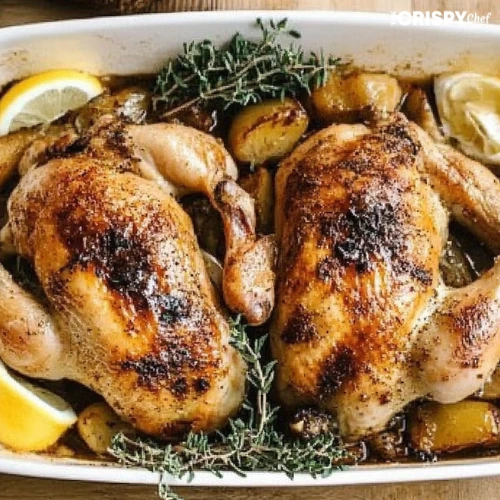
Cast Iron Skillet Cornish Hen
Equipment
- Cast iron skillet
- Roasting Pan
- Food processor
- Meat thermometer
Ingredients
- 4 Cornish hens 1-2 pounds each
- 3 cloves garlic minced
- 1 teaspoon paprika
- 1/2 teaspoon allspice
- 1 tablespoon fresh thyme chopped
- 1/2 teaspoon black pepper
- 1/4 teaspoon nutmeg
- 2 tablespoons olive oil
- 1 teaspoon salt
- 2 tablespoons citrus juice lemon or orange
- 1 lemon quartered (for stuffing)
- 1 onion quartered (for stuffing)
- 1 celery stalk cut into pieces (for stuffing)
- 1/2 cup chicken broth for basting
Instructions
- Preheat oven to 425°F (220°C).
- Thaw Cornish hens in the refrigerator overnight. Pat dry with paper towels.
- In a food processor, blend garlic, paprika, allspice, thyme, black pepper, nutmeg, olive oil, salt, and citrus juice. Coat hens with the marinade, inside and out, and let marinate for at least 1 hour or overnight.
- Stuff each hen with lemon wedges, onion, and celery.
- Heat a cast iron skillet over medium-high heat. Sear hens skin-side down for 2-3 minutes until crispy and golden. Flip and sear the other side.
- Transfer the skillet to the preheated oven. Roast for 25 minutes at 425°F, then reduce temperature to 350°F and roast for another 20-25 minutes.
- Baste with chicken broth every 15 minutes during roasting. Use a meat thermometer to ensure the internal temperature reaches 165°F.
- Remove from oven, rest for 10 minutes before serving.
Notes
- Ensure Cornish hens are thoroughly thawed and patted dry for a crispy skin.
- You can marinate the hens overnight for deeper flavor.
- Use a meat thermometer to ensure the hens are fully cooked.
- Leftovers can be stored in an airtight container in the fridge for up to 4 days or frozen for up to 4 months.
